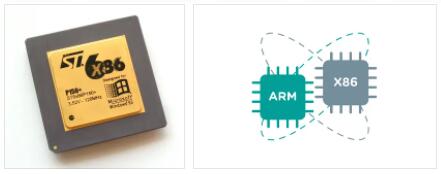X86. Generic denomination given to certain Microprocessors of the Intel family, their compatible ones and the basic architecture to which these processors belong, by the ending of their numerical names: 8086, 80286, 80386, 80486, etc. According to abbreviationfinder, they have been a standard for computers of the IBM PC Compatible type since their birth . They are commonly known by shortened versions of their names, such as 286 or I286, 386 or I386, 486 or I486, and even 086, for I8086 or I8088 (their respective 8-bit version). The commercial popularity of this architecture caused many manufacturers, in addition to Intel, to begin mass-producing microprocessors based on this architecture. These companies include AMD, Cyrix, NEC Corporation and Transmeta, among others.
History
The architecture known as x86 begins in 1978 with the Intel 8086/88 processors (although the 4004, 8080, and 8085 had previously appeared .). These processors belonged to the IA-16 architecture (Intel Architecture 16 bits).
Throughout its evolution, since 1978, Intel has maintained binary compatibility with preceding processors. This compatibility breaks with the Itanium and Itanium2 processors, with IA-64 architecture, which are totally incompatible with their predecessors.
The (80)386 was Intel’s first processor with a 32-bit instruction set (IA-32). Both the operands and the addressing in memory use 32 bits, so the 386 has a 4GB address space.
The 386 is also the first to introduce a paging MMU, with a fixed page size of 4KB. Previous processors already had a segmentation scheme, which in the 386 can be bypassed by using a flat memory scheme.
Some processors with x86 architecture
intel processors
- 80486DX2 and an Intel 80386.
- Intel Pentium.
- Intel PentiumII.
- Intel PentiumIII.
- Intel Pentium 4.
AMD processors
- AMD Athlon.
- AMD Athlon 64.
- AthlonXP.
- AMD Duron.
- AMD Opteron.
- AMD Sempron.
Operating modes
- Protected mode: It is the normal operating mode of the processor, in which all its features are available.
- Real-addressing mode: This is a compatibility mode with the 8086, except for the ability to switch to protected mode. The processor always starts its execution in this mode (after boot or reset).
- Maintenance mode: It is a mode entered by an APIC interrupt, useful only for operating system maintenance tasks (management of power control or security).
Basic characteristics
- The x86 architecture is a variable instruction length, memory register type, and CISC design.
- Linear address space is 4GB, although physical memory can go up to 64GB on some models, with unaligned access and Little-endian storage.
- A typical program has 8 32-bit general purpose registers, 6 16-bit segment registers, an EFLAGS status register, and an EIP instruction pointer, both 32-bit. These registers can be accessed from general purpose operations, made up of integer arithmetic instructions, flow control instructions, bit and byte string operations, and memory access instructions.
- A set of 8 80-bit floating point registers, a set of 8 MMX and XMM registers, 64 and 128 bits respectively, to perform SIMD operations.
- A set of resources for stack handling and subroutine invocation.
- The OS also has I/O ports, control registers, memory management, debugging, monitoring, etc.
